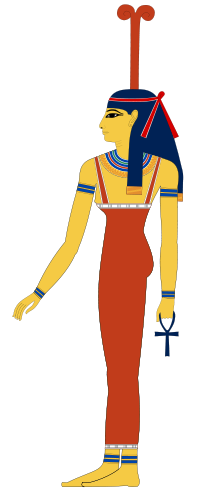- Meskhenet
-
Meskhenet 
Meskhenet as a woman with a symbolic cow's uterus on her headGoddess of childbirth Symbol Cow's uterus Consort Andjety In Ancient Egyptian mythology, Meskhenet, (also spelt Mesenet, Meskhent, and Meshkent) was the goddess of childbirth, and the creator of each child's Ka, a part of their soul, which she breathed into them at the moment of birth. She was worshipped from the earliest of times by Egyptians.
Contents
In mythology
In ancient Egypt, women delivered babies while squatting on a pair of bricks, known as birth bricks, and Meskhenet was the goddess associated with this form of delivery. Consequently, in art, she was sometimes depicted as a brick with a woman's head, wearing a cow's uterus upon it. At other times she was depicted as a woman with a symbolic cow's uterus on her headdress.
Since she was responsible for creating the Ka, she was associated with fate. Thus later she was sometimes said to be paired with Shai, who became a god of destiny after the deity evolved out of an abstract concept.[1]
It was said that Meskhenet was present at the birth of triplets, and foretold in their fates, that they would each be pharaohs - the triplets in question were Sahure, Userkaf, and Neferirkare Kakai, who were the first pharaohs in the fifth dynasty (although Userkaf was not the sibling of the other two, but their father).
Meskhenet also was believed to be the earliest wife of Andjety the god of rebirth in the underworld. Andjety appears to have been worshipped since pre-dynastic times at Andjet, and is thought by most Egyptologists to be the god who eventually became Osiris.
Gallery
See also
References
External links
Ancient Egyptian religion Mythology 


Deities Amun · Amunet · Anubis · Anuket · Apep · Apis · Aten · Atum · Bastet · Bat · Bes
Four sons of Horus · Geb · Hapi · Hathor · Heka · Heqet · Horus · Isis · Khepri
Khnum · Khonsu · Kuk · Maahes · Ma'at · Mafdet · Menhit · Meretseger · Meskhenet
Monthu · Min · Mnewer · Mut · Neith · Nekhbet · Nefertem · Nephthys · Nu · Nut · Osiris
Pakhet · Ptah · Qebui · Ra · Reshep · Satet · Sekhmet · Seker · Serket · Sobek
Sopdet · Sopdu · Set · Seshat · Shu · Taweret · Tefnut · Tatenen · Thoth · Wadjet
Wadj-wer · Wepwawet · WosretWritings Beliefs Categories:- Creator goddesses
- Childhood goddesses
- Egyptian goddesses
- Fertility goddesses
Wikimedia Foundation. 2010.



